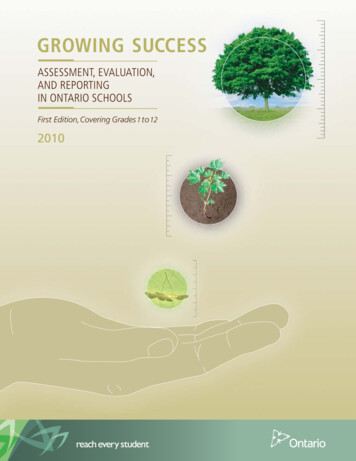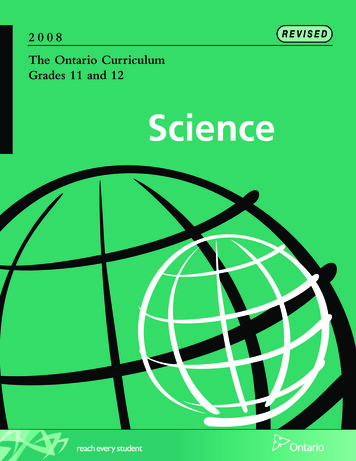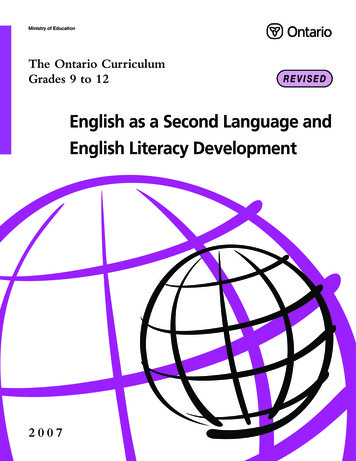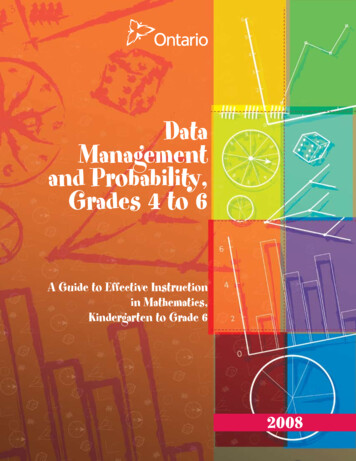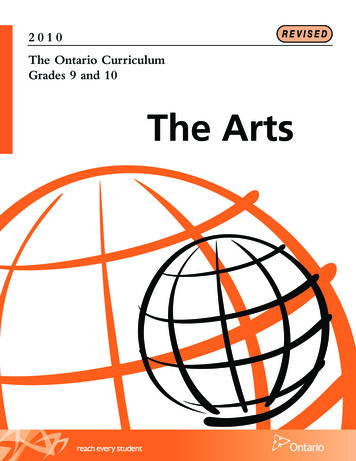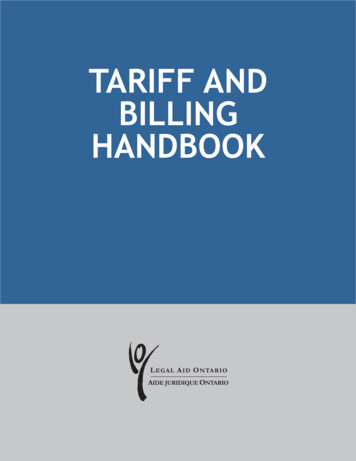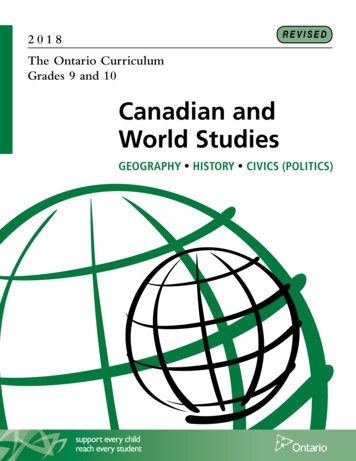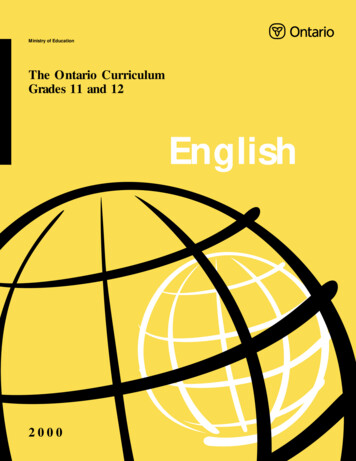
Transcription
Ministry of EducationThe Ontario CurriculumGrades 11 and 12English2000
Contents.2The Place of English in the Curriculum . . . . . . . . . . . . . . . . . . . . . . . . . . . . . . . . . . . .2The Program in English . . . . . . . . . . . . . . . . . . . . . . . . . . . . . . . . . . . . . . . . . . . . . . .4Overview . . . . . . . . . . . . . . . . . . . . . . . . . . . . . . . . . . . . . . . . . . . . . . . . . . . . . . . . . .4Teaching Approaches . . . . . . . . . . . . . . . . . . . . . . . . . . . . . . . . . . . . . . . . . . . . . . . . . .7Curriculum Expectations . . . . . . . . . . . . . . . . . . . . . . . . . . . . . . . . . . . . . . . . . . . . . . .7Strands . . . . . . . . . . . . . . . . . . . . . . . . . . . . . . . . . . . . . . . . . . . . . . . . . . . . . . . . . . . .8IntroductionCompulsory Courses . . . . . . . . . . . . . . . . . . . . . . . . . . . . . . . . . . . . . . . . . . . . . . . . . . 12English, Grade 11, University Preparation (ENG3U) . . . . . . . . . . . . . . . . . . . . . . . . . . . 13English, Grade 11, College Preparation (ENG3C) . . . . . . . . . . . . . . . . . . . . . . . . . . . . . 22English, Grade 11,Workplace Preparation (ENG3E) . . . . . . . . . . . . . . . . . . . . . . . . . . . 31English, Grade 12, University Preparation (ENG4U) . . . . . . . . . . . . . . . . . . . . . . . . . . . 40English, Grade 12, College Preparation (ENG4C) . . . . . . . . . . . . . . . . . . . . . . . . . . . . . 49English, Grade 12,Workplace Preparation (ENG4E) . . . . . . . . . . . . . . . . . . . . . . . . . . . 58Optional Courses . . . . . . . . . . . . . . . . . . . . . . . . . . . . . . . . . . . . . . . . . . . . . . . . . . . . 67Canadian Literature, Grade 11, University/College Preparation (ETC3M) . . . . . . . . . . . 68Literacy Skills: Reading and Writing, Grade 11, Open (ELS3O). . . . . . . . . . . . . . . . . . 72Media Studies, Grade 11, Open (EMS3O) . . . . . . . . . . . . . . . . . . . . . . . . . . . . . . . . . . . 78Presentation and Speaking Skills, Grade 11, Open (EPS3O). . . . . . . . . . . . . . . . . . . . . 84Studies in Literature, Grade 12, University Preparation (ETS4U) . . . . . . . . . . . . . . . . . . 89The Writer’s Craft, Grade 12, University Preparation (EWC4U) . . . . . . . . . . . . . . . . . . . 93Studies in Literature, Grade 12, College Preparation (ETS4C) . . . . . . . . . . . . . . . . . . . . 97The Writer’s Craft, Grade 12, College Preparation (EWC4C) . . . . . . . . . . . . . . . . . . . . 101Communication in the World of Business and Technology, Grade 12, Open (EBT4O). . 105Some Considerations for Program Planning in English . . . . . . . . . . . . . . . . . . . . . . . . 110The Achievement Chart for English . . . . . . . . . . . . . . . . . . . . . . . . . . . . . . . . . . . . . . . 112This publication is available on the Ministry of Education’swebsite at http://www.edu.gov.on.ca.
2IntroductionThe Ontario Curriculum, Grades 11 and 12: English, 2000 will be implemented in Ontario secondary schools starting in September 2001 for students in Grade 11 and September 2002 forstudents in Grade 12. This document replaces the following curriculum guidelines or thoseparts of guidelines that relate to the senior grades:– English, Intermediate and Senior Divisions (Grades 7–12), 1987– English, Ontario Academic Courses, Senior Division, 1984– Business Studies: Business English, Senior Division, 1987This document is designed for use in conjunction with The Ontario Curriculum, Grades 9 to 12:Program Planning and Assessment, 2000, which contains information relevant to all disciplinesrepresented in the curriculum. The planning and assessment document is available both inprint and on the ministry’s website, at http://www.edu.gov.on.ca.The Place of English in the CurriculumTo participate fully in the society and workplace of the twenty-first century, today’s studentswill need to be able to use language skilfully, confidently, and flexibly. The English curriculumoffers a challenging program of the highest quality, one that recognizes the central importanceof language and literature in learning and everyday life and prepares students for the literacydemands they will face as Canadians and members of the global community. Equally important, the English program encourages students to develop a lifelong love of reading andwriting.Language is the basis for thinking, communicating, and learning. Students need literacy skillsto enable them to receive and comprehend ideas and information, to inquire further into areasof interest and study, to express themselves clearly, and to demonstrate their learning. Literacyskills are important for higher education and for eventual entry into the workplace. Studentswho are preparing for postsecondary education must develop literacy skills, as well as criticalthinking skills, in order to succeed in the challenging academic work of university and collegeprograms. Students who are preparing for careers in business and industry also need these skillsin order to adapt to a workplace that is constantly changing. Whatever their postsecondarydestination, all students need to be able to think critically and creatively and to express themselves clearly and effectively. Learning to communicate with clarity and precision, both orallyand in writing, will help students to thrive in their future endeavours in the world beyondthe school.Literature is a fundamental element of identity and culture. As students read and reflect on arich variety of literature, informational texts, and media works, they deepen their understanding of themselves and the world around them. In their study of literary works by accomplished writers and from many genres, historical periods, and cultures, students consider personal and societal aspirations and explore possibilities. Through the study of literature,students strengthen their ability to use language as an effective tool for thought, expression,and communication.
3INTRODUCTIONLanguage is also an essential tool for learning across the curriculum. When students considertopics, issues, or themes in various subject areas, they use and develop important literacy skills.For example, in science and technology, students must communicate effectively to recordobservations, describe investigations, and present their findings in oral and written reports.They must also learn to use many technical terms and types of specialized language. Facility inlanguage helps students to learn in all subject areas; at the same time, by using language for abroad range of purposes students increase their ability to communicate with precision and tounderstand how language works.Students in Ontario come from a wide variety of backgrounds. This variety enriches the classroom experience in the same way that the study of authors from different cultures contributesto a greater appreciation of literature. There is no single correct way to teach or learn English;it is assumed that the strategies and resources used will vary according to the object of thelearning and the needs of the students.Subject matter from any course in English can be combined with subject matter from oneor more courses in other disciplines to create an interdisciplinary course. The policies andprocedures regarding the development of interdisciplinary courses are outlined in the interdisciplinary studies curriculum policy document.Language learning is developmental and cumulative across the grades: students develop flexibility and proficiency in their understanding and use of language over time. The secondaryschool English curriculum for Grades 11 and 12 therefore builds on the expectations outlinedin The Ontario Curriculum, Grades 9 and 10: English, 1999, and provides students and teacherswith clearly stated, rigorous, and increasingly demanding expectations. In each grade in thesecondary curriculum, the expectations increase in scope and complexity. As students movethrough the grades, they are required to use language with ever greater fluency, proficiency,and accuracy in a broadening range of situations. They take greater responsibility for their ownlearning and apply their language skills in more challenging and complex ways.Although students in Grades 11 and 12 will continue practising skills covered in Grades 9 and10, the emphasis in the senior secondary grades is on helping students consolidate the skillsand knowledge they need to prepare for their postsecondary destinations. This emphasis willensure that students develop independence and master the range of complex skills they willneed for university and college programs and for the workplace.
4The Program in EnglishOverviewThe English program includes compulsory courses, which are required for graduation, andoptional courses, which are elective credits offered only in Grades 11 and 12.Compulsory courses emphasize strong core competencies in reading, writing, use of language,and media awareness. As part of their program in Grades 11 and 12, students must take a compulsory course in English in each grade. They may choose their compulsory courses fromthree types of courses in Grades 11 and 12: university preparation, college preparation, andworkplace preparation. (See The Ontario Curriculum, Grades 9 to 12: Program Planning andAssessment, 2000 for a description of the different types of secondary school courses.)Optional courses provide students with opportunities to explore individual interests and todeepen and extend some of the knowledge and skills acquired in their compulsory coursesthrough more thematic and specialized study. Four types of optional courses are offered:university preparation, university/college preparation, college preparation, and open. Studentsmay choose to take one of the optional English courses to fulfil an additional compulsorycredit requirement for graduation.Compulsory Courses in English, Grades 11 and 12GradeCourse NameCourse TypeCourse CodePrerequisites11English*UniversityENG3UGrade 10 English, Academic11English*CollegeENG3CGrade 10 English, Applied11English*WorkplaceENG3EGrade 10 English, Applied12EnglishUniversityENG4UGrade 11 English, University12EnglishCollegeENG4CGrade 11 English, College12EnglishWorkplaceENG4EGrade 11 English, WorkplaceNote: Each of the courses listed above is worth one credit.* Credit earned for the Grade 11 Native studies course “English: Contemporary Aboriginal Voices”(University, College, or Workplace Preparation) may be used to meet the Grade 11 English compulsorycredit requirement. (See Ontario Secondary Schools, Grades 9 to 12: Program and Diploma Requirements, 1999,Appendix 5: Compulsory Credits, and the secondary curriculum policy document for Native studies.)
5THE PROGRAM IN ENGLISHOptional Courses in English, Grades 11 and 12GradeCourse NameCourse TypeCourse CodePrerequisites11Canadian LiteratureUniversity/CollegeETC3M11Literacy Skills:Reading and WritingOpenELS3OGrade 10 English,Academic or AppliedNone11Media StudiesOpenEMS3OGrade 10 English,Academic or Applied11Presentation andSpeaking SkillsOpenEPS3OGrade 10 English,Academic or Applied12Studies in LiteratureUniversityETS4UGrade 11 English, University12The Writer’s CraftUniversityEWC4UGrade 11 English, University12Studies in LiteratureCollegeETS4CGrade 11 English, College12The Writer’s CraftCollegeEWC4CGrade 11 English, College12Communication inthe World of Businessand TechnologyOpenEBT4OGrade 11 English,University, College,or WorkplaceNote: Each of the courses listed above is worth one credit.A Note About Credits. Courses in Grades 11 and 12 are designed to be offered as full-creditcourses. However, half-credit courses may be developed for specialized programs, such asschool-work transition and apprenticeship programs, as long as the original course is not designated as a requirement for entry into a university program. Individual universities will identify the courses that are prerequisites for admission to specific programs. Such courses must beoffered as full-credit courses, to ensure that students meet admission requirements.In Grades 9-12, half-credit courses, which require a minimum of fifty-five hours of scheduledinstructional time, must adhere to the following conditions: The two half-credit courses created from a full course must together contain all of theexpectations of the full course, drawn from all of the strands of that course and divided in amanner that best enables students to achieve the required knowledge and skills in the allotted time. A course that is a prerequisite for another course in the secondary curriculum may beoffered as two half-credit courses, but students must successfully complete both parts of thecourse to fulfil the prerequisite. (Students are not required to complete both parts unless thecourse is a prerequisite for another course that they wish to take.) The title of each half-credit course must include the designation Part 1 or Part 2. A halfcredit (0.5) will be recorded in the credit-value column of both the report card and theOntario Student Transcript.Boards will ensure that all half-credit courses comply with the conditions described above, andwill report all half-credit courses to the ministry annually in the School September Report.
6THE ONTARIO CURRICULUM, GRADES 11 AND 12: ENGLISHPrerequisite Charts for English, Grades 9–12These charts map out all the courses in the discipline and show the links between courses and the possible prerequisites for them.They do not attempt to depict all possible movements from course to course.Compulsory CoursesEnglishEnglishEnglishEnglishGrade 9, AcademicGrade 10, AcademicGrade 11, UniversityGrade 12, UniversityEnglishEnglishGrade 9, AppliedGrade 10, AppliedEnglishEnglishGrade 11, CollegeGrade 12, CollegeEnglishEnglishGrade 11, WorkplaceGrade 12, WorkplaceOptional CoursesEnglishEnglishStudies in LiteratureGrade 11, UniversityGrade 12, UniversityCanadian LiteratureThe Writer’s CraftGrade 11, University/CollegeGrade 12, UniversityEnglishCommunication in the World ofBusiness and TechnologyGrade 11, WorkplaceGrade 12, OpenGrade 10, AcademicEnglishStudies in LiteratureGrade 11, CollegeGrade 12, CollegeMedia StudiesThe Writer’s CraftGrade 11, OpenGrade 12, CollegeEnglishGrade 10, AppliedPresentation and Speaking SkillsGrade 11, OpenLiteracy Skills: Reading and WritingGrade 11, OpenNote: Dotted lines indicate compulsory courses.
THE PROGRAM IN ENGLISH7Teaching ApproachesTeachers will use their professional judgement to decide which instructional methods will bemost effective in promoting the learning of core knowledge and skills described in theexpectations.Language is best learned through direct instruction and classroom activities that present stimulating ideas, issues, and themes that are meaningful to students. Since no single instructionalapproach can address all the curriculum expectations or meet all the needs of each learner,teachers should select instructional strategies and classroom activities that are based on anassessment of students’ needs, proven learning theory, and best practices. In their English programs, teachers should introduce a rich variety of activities that integrate expectations from thedifferent strands and provide for the explicit teaching of knowledge and skills.The ability to work both independently and collaboratively is important for success in theworkplace and postsecondary education and is equally relevant in the context of family andcommunity. It is therefore important for students to have opportunities to develop theirEnglish skills and knowledge in a variety of ways: individually and cooperatively; independently and with teacher direction; and through the study of examples followed by practice.Students must be able to demonstrate that they have acquired the specified knowledge andskills.Curriculum ExpectationsThe expectations identified for each course describe the knowledge and skills that students areexpected to develop and demonstrate in their class work, on tests, and in various other activities through which their achievement is assessed and evaluated.Two sets of expectations are listed for each strand, or broad curriculum area, of each course.The overall expectations describe in general terms the knowledge and skills that students areexpected to demonstrate by the end of each course. The specific expectations describe theexpected knowledge and skills in greater detail. The specific expectations are organized undersubheadings that reflect particular aspects of the required knowledge and skills and that mayserve as a guide for teachers as they plan learning activities for their students.The organizationof expectations in strands and subgroupings is not meant to imply that the expectations in anyone strand or group are achieved independently of the expectations in the other strands orgroups.Many of the expectations are accompanied by examples, given in parentheses. These examplesare meant to illustrate the kind of skill, the specific area of learning, the depth of learning,and/or the level of complexity that the expectation entails. They are intended as a guide forteachers rather than as an exhaustive or mandatory list.
8THE ONTARIO CURRICULUM, GRADES 11 AND 12: ENGLISHStrandsCompulsory CoursesThe strands for compulsory courses are as follows: Literature Studies and Reading,Writing,Language, and Media Studies.Literature Studies and Reading. Since students will vary in their reading proficiency, some maycontinue to need additional support to develop their reading skills and to monitor their ownprogress. In addition, all students need instruction to cope with the more challenging readingdemands of the senior secondary school curriculum, which requires students to considerincreasingly difficult concepts and to use language structures that are more complex andvocabulary that is more specialized than in earlier grades. The English program will help students learn to read efficiently and to absorb information quickly. Students will also learn toswitch from one genre to another, and to use a range of reading skills to suit their purpose andthe materials they are reading as they move from subject to subject. Students should beencouraged to read independently for pleasure, information, and comprehension.The study of literature is central in the English curriculum; it offers students opportunities toexpand their intellectual horizons and to extend and strengthen their literacy skills. As a creative representation of life and experience, literature raises important questions about thehuman condition, now and in the past. As students increase their knowledge of accomplishedwriters and literary works and vicariously experience times, events, cultures, and values different from their own, they deepen their understanding of the many dimensions of humanthought and human experience.All students, regardless of their postsecondary plans, need to read a balance of exemplary literary and informational works that nourish the imagination, promote intellectual growth, contribute to a sense of literary appreciation, and provide a broad range of language models fortheir own writing. Literary works should be drawn from many genres, historical periods, andcultures to reflect the diversity of Canada and the world. Such works include:– poetry (poets such as Dionne Brand, Elizabeth Barrett Browning, Leonard Cohen, EmilyDickinson, John Donne,T.S. Eliot, Robert Frost, Langston Hughes, John Keats, JohnMilton, Derek Walcott,William Wordsworth);– novels (novelists such as Chinua Achebe, Margaret Atwood, Jane Austen, Charlotte Brontë,Joseph Conrad, Robertson Davies, Fyodor Dostoyevsky,Timothy Findley,Thomas Hardy,Ernest Hemingway, Aldous Huxley, Rohinton Mistry,Toni Morrison, Michael Ondaatje,Carol Shields, John Steinbeck, Stendhal, Elie Wiesel);– plays (playwrights such as Carol Bolt, Anton Chekhov, David French,Tomson Highway,Henrik Ibsen, Arthur Miller,William Shakespeare, George Bernard Shaw,Tom Stoppard,Michel Tremblay,Tennessee Williams);– short stories (writers such as Alice Munro and Edgar Allan Poe).Genres such as biographies, journals, letters, and essays are also worth including. (The preceding lists of authors are provided to indicate the level of challenge that programs in literaturestudies should entail, and are not intended to suggest prescribed reading.) Literary worksenrich students’ understanding of themes and issues and enhance their appreciation of thepower and beauty of language. To help students become confident, proficient, flexible readers,a balanced literature program also includes a range of informational texts, such as academictextbooks, technical manuals, newspapers and magazines, reference materials, memos, bulletinboard notices, CD-ROMs, databases, and websites.
THE PROGRAM IN ENGLISH9When choosing literature, teachers must consider the genres designated for intensive study inthe curriculum expectations, as well as an appropriate balance among contemporary, historical,Canadian, and world literature.Writing. Students use writing to record information and ideas, to express themselves, to communicate with others for various purposes, and to reflect and learn. In personal, academic, andworkplace situations, students need to be able to write clearly and coherently, with precisionand an engaging style. A central goal of the Writing strand is to promote students’ growth asconfident writers and researchers who can communicate competently, using a range of formsand styles to suit specific purposes and audiences and correctly applying the conventions oflanguage – grammar, usage, spelling, and punctuation. These conventions are best learned inthe context of meaningful and creative writing activities that allow students to develop theability to think and write clearly and effectively. When planning writing activities, teachersmust include the forms designated for intensive study in the curriculum expectations, as wellas an appropriate balance of other forms of writing.Writing, from initial musings to final publication, is a complex process that involves a range ofcomplementary thinking and composing skills, as well as other language processes, includingreading, speaking, and listening. As writers compose, they consider their audience; make decisions about form, style, and organization; and apply their knowledge of language use, includingthe conventions of grammar, spelling, and punctuation. To develop competence in these areas,students need a supportive classroom environment, with opportunities to extend and refinetheir skills in using the writing process and doing research. They also need opportunities toapply these skills and to write daily, in many forms and genres, for a variety of purposes andaudiences, and within different time constraints. The forms and genres explored shouldinclude essays, reports, short stories, poetry, scripts, journals, letters, biographies, children’s stories, articles, reviews, précis, instructions, notes, procedures, résumés, and advertisements.Because postsecondary institutions and employers require clear, well-organized writing, ondemand and within strict timelines, students also need to learn and practise strategies for writing effectively and correctly in the context of examinations and in-class writing assignments.To help them in their writing and research, students need access to a range of print and electronic resources, including general and specialized dictionaries, thesauri, manuals of style,word-processing and graphics software, desktop publishing programs, e-mail, and the Internet.Students should be encouraged to write frequently for pleasure and personal purposes.Language. The Language strand sets out expectations for vocabulary development, knowledgeof the history of the English language, knowledge of the conventions of standard CanadianEnglish, and oral communication skills.Knowledge of vocabulary helps students improve their reading, writing, and speaking skills.The study of the development of the English language – the influence on English of otherlanguages, historical events, and trends – and of the nature of dialects and world Englisheshelps students appreciate the evolving nature of language. Knowledge of the rules of standardgrammar and the conventions of spelling and punctuation helps students to understand, write,and speak standard Canadian English confidently and correctly in all subject disciplines. Thus,the study of the conventions of standard Canadian English is a component of all compulsoryEnglish courses.
10THE ONTARIO CURRICULUM, GRADES 11 AND 12: ENGLISHOral language is a fundamental means for communicating with others and the cornerstone oflearning in all subjects. Students listen and speak in order to understand concepts, solve problems, provide information, and express thoughts. When they converse about information andideas, they become aware of forms, styles, imagery, language structures, and conventions usedby other speakers and writers. As they work towards achieving the expectations for this strand,students will improve their ability to explore and communicate ideas in both classroom andformal speaking situations. Students should be encouraged to appreciate and take pleasure inthe power and beauty of language.Media Studies. Because of the pervasive influence of print and electronic media, it is importantfor students to learn how to understand and interpret media works. In the English program,students should have frequent opportunities to analyse various aspects of media communications, including key elements of the works themselves, the audience, and media industry codesand practices. Students should also learn about the media through the process of designing orcreating their own media works, using a range of technologies to do so. By working in thevarious media to communicate their own ideas, students will develop critical thinking skillsand understand at first hand how media works are designed to influence audiences and reflectthe perspectives of their creators. Students will also develop production skills that may openup career opportunities in the entertainment and communication industries. Students shouldbe encouraged to appreciate the media as sources of personal information and pleasure.Optional CoursesThe optional courses in the English program provide students with the same language knowledge and skills in reading, writing, and oral and visual communication as do the compulsorycourses, but the focus of each of these courses is more thematic or specialized than in thecompulsory courses. The expectations are therefore clustered in strands that reflect eachcourse’s emphasis. A list of these strands by course is provided below.Grade 11 Canadian Literature, University/College Preparation– Reading and Interpreting Canadian Literary Texts– Responding to Canadian Literary Texts Literacy Skills: Reading and Writing, Open– Reading Skills– Writing Skills Media Studies, Open– Media Texts– Media Audiences– Media Production Presentation and Speaking Skills, Open– Preparing Presentations– Making Presentations– Responding to Presentations
THE PROGRAM IN ENGLISHGrade 12 Studies in Literature, University Preparation– Reading and Interpreting Literary Texts– Responding to Literary Texts The Writer’s Craft, University Preparation– Investigating the Writer’s Craft– Practising the Writer’s Craft Studies in Literature, College Preparation– Reading and Interpreting Literary Texts– Responding to Literary Texts The Writer’s Craft, College Preparation– Investigating the Writer’s Craft– Practising the Writer’s Craft Communication in the World of Business and Technology, Open– Investigating Business and Technical Communications– Creating Business and Technical Communications11
12Compulsory Courses
13English, Grade 11, University Preparation(ENG3U)This course emphasizes the development of literacy, critical thinking, and communicationskills. Students will analyse challenging texts from various periods; conduct research andanalyse the information gathered; write persuasive and literary essays; and analyse the relationship among media forms, audiences, and media industry practices. An important focus will beon understanding the development of the English language.Prerequisite: English, Grade 10, Academic
14THE ONTARIO CURRICULUM, GRADES 11 AND 12: ENGLISHLiterature Studies and ReadingOverall ExpectationsBy the end of this course, students will: read and demonstrate an understanding of texts from various periods, with an emphasis onanalysing and assessing information, ideas, themes, issues, and language; demonstrate an understanding of the elements of fiction, drama, poetry, and non-fiction,with an emphasis on novels and poems; describe the elements of style in texts from various periods, and analyse their effects.Specific ExpectationsUnderstanding the Meaning of TextsBy the end of this course, students will:– analyse and interpret information, ideas,themes, and arguments in print and electronic texts (e.g., write a paper analysing atheme in a novel; explain explicit andimplicit claims made in a persuasive essay);– select and use specific and relevant evidence from a close reading of texts to support interpretations, analyses, and arguments (e.g., analyse and describe theorganization of an argument in a literaryessay; identify the target and explain thecriticism in a work of satire);– select and use a range of effective readingstrategies (e.g., make, adjust, and defendpredictions while reading a novel; adjustreading pace as the complexity of a textchanges; reread a text closely to relaterepeated images to a theme);– compare their own ideas, values, and perspectives with those expressed or impliedin a text (e.g., analyse the thinking andresponse of a fictional character in a crisisand compare them with their own probable reactions; debate two
- English,Intermediate and Senior Divisions (Grades 7-12),1987 - English,Ontario Academic Courses,Senior Division,1984 - Business Studies: Business English,Senior Division,1987 This document is designed for use in conjunction with The Ontario Curriculum,Grades 9 to 12: Program Planning and Assessment,2000, which contains information relevant to all disciplines represented in the .

